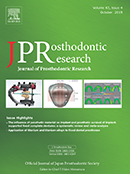Special Edition
Volume 63, Issue 4
Displaying 1-12 of 12 articles from this issue
- |<
- <
- 1
- >
- >|
Editorial
-
2019Volume 63Issue 4 Pages v
Published: 2019
Released on J-STAGE: March 20, 2020
Download PDF (183K)
Review Article
-
2019Volume 63Issue 4 Pages 389-395
Published: 2019
Released on J-STAGE: March 20, 2020
Download PDF (880K)
Original Articles
-
2019Volume 63Issue 4 Pages 396-403
Published: 2019
Released on J-STAGE: March 20, 2020
Download PDF (1616K) -
2019Volume 63Issue 4 Pages 404-410
Published: 2019
Released on J-STAGE: March 20, 2020
Download PDF (2069K) -
2019Volume 63Issue 4 Pages 411-414
Published: 2019
Released on J-STAGE: March 20, 2020
Download PDF (252K) -
2019Volume 63Issue 4 Pages 415-420
Published: 2019
Released on J-STAGE: March 20, 2020
Download PDF (1179K) -
2019Volume 63Issue 4 Pages 421-427
Published: 2019
Released on J-STAGE: March 20, 2020
Download PDF (647K) -
2019Volume 63Issue 4 Pages 428-433
Published: 2019
Released on J-STAGE: March 20, 2020
Download PDF (726K) -
2019Volume 63Issue 4 Pages 434-439
Published: 2019
Released on J-STAGE: March 20, 2020
Download PDF (960K) -
2019Volume 63Issue 4 Pages 440-446
Published: 2019
Released on J-STAGE: March 20, 2020
Download PDF (956K) -
2019Volume 63Issue 4 Pages 447-452
Published: 2019
Released on J-STAGE: March 20, 2020
Download PDF (2432K) -
2019Volume 63Issue 4 Pages 453-459
Published: 2019
Released on J-STAGE: March 20, 2020
Download PDF (2241K)
- |<
- <
- 1
- >
- >|
